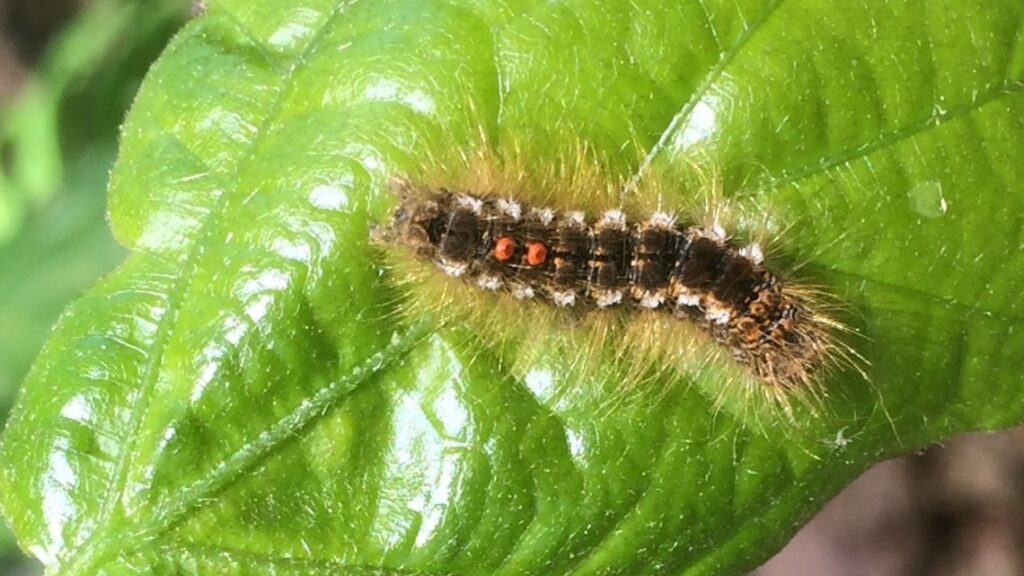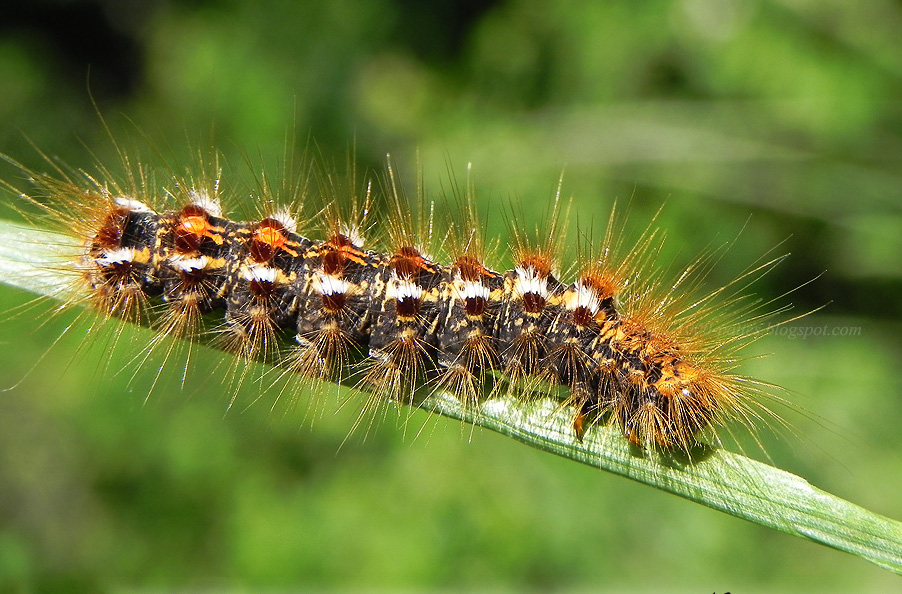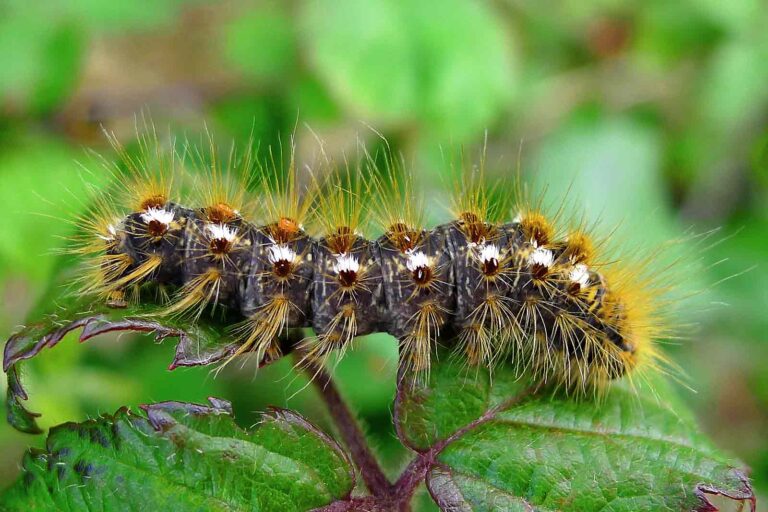Getting rid of brown tail moth caterpillars can be challenging due to their irritating hairs, which can cause skin rashes and respiratory problems. It’s important to take precautions when dealing with these caterpillars. Here are some quick steps to help you manage and remove them:
- Protect yourself with appropriate clothing and gear.
- Remove caterpillars manually, placing them in soapy water to drown.
- Use a vacuum cleaner to collect caterpillars and dispose of the contents properly.
- Consider using caterpillar-specific pesticides with Bacillus thuringiensis var. kurstaki (Bt-k) or spinosad.
- Trim and prune infested plants, and wrap tree trunks with burlap or tape.
- Remove caterpillar nests when small.
- Encourage natural predators like birds and parasitic wasps.
How to stay safe with brown tail moth caterpillars?

In the midst of nature’s beauty, the presence of brown tail moth caterpillars can pose a hidden threat, but with the right knowledge and precautions, you can enjoy the outdoors safely.
Importance of Protective Clothing and Gear
Covering Exposed Skin: It is crucial to wear clothing that covers as much skin as possible, including long sleeves, pants, and gloves. The goal is to minimize direct contact with the caterpillars and their irritating hairs.
Choosing the Right Materials: Opt for thick, tightly woven fabrics that caterpillar hairs are less likely to penetrate. Moreover, avoid loose-fitting clothing, as it may allow the hairs to come into contact with your skin.
Wearing a Mask: Wearing a mask is advisable, especially when handling caterpillars in areas with a high population. Furthermore, a mask helps prevent inhalation of airborne caterpillar hairs, reducing the risk of respiratory irritation.
Eye Protection: If you have to work in close proximity to the caterpillars or their nests, consider wearing goggles or protective eyewear to shield your eyes from any airborne hairs.
Potential Health Risks Associated with Brown Tail Moth Caterpillars
Skin Irritation: The primary health risk associated with brown tail moth caterpillars is skin irritation. The caterpillar hairs are covered in microscopic barbs that can embed themselves in your skin, leading to redness, itching, and rash-like symptoms. In some cases, these reactions can be severe.
Respiratory Issues: Inhaling airborne caterpillar hairs can irritate the respiratory tract and cause symptoms such as coughing, sneezing, a runny nose, and, in rare cases, more severe respiratory distress. People with preexisting respiratory conditions are particularly vulnerable.
Eye Irritation: Contact with caterpillar hairs in the eyes can result in redness, itching, and eye discomfort. Eye protection is essential when working in areas with active caterpillar infestations.
Immediate Actions to Take if Exposed to Caterpillar Hairs
Skin Contact: If you come into contact with caterpillar hairs or experience skin irritation, immediately wash the affected area with soap and water. Use tape to gently lift any embedded hairs from the skin.
In addition, applying an over-the-counter antihistamine cream or taking an oral antihistamine can help relieve itching and inflammation.
Eye Contact: If caterpillar hairs enter your eyes, flush your eyes gently with cool, clean water for at least 15 minutes. Seek immediate medical attention if irritation persists or if you experience severe eye discomfort.
Respiratory Irritation: If you inhale caterpillar hairs and experience respiratory irritation, move to an area with fresh air. Rest and avoid exertion. If symptoms worsen or persist, seek medical attention promptly.
How to manually remove brown tail moth caterpillars effectively?
When encountering brown tail moth caterpillars, knowing how to safely and effectively remove them by hand can be a valuable skill, minimizing the risk of irritation and discomfort.
Using Gloves and Sticks to Pick Caterpillars off Plants and Structures
Gloves: When handling brown tail moth caterpillars manually, it’s crucial to wear protective gloves made of a material that caterpillar hairs cannot penetrate.
In addition, nitrile or latex gloves, when worn properly, can provide adequate protection. Ensure the gloves are in good condition without tears or holes.
Sticks or Tweezers: Instead of using your bare hands, use sticks, tweezers, or other tools to gently lift the caterpillars from plants and structures. This minimizes direct contact with the caterpillars and reduces the risk of skin irritation.
Be Gentle: Handle the caterpillars gently to avoid crushing them. Carefully place them in a container for later disposal.
Submerging Caterpillars in Soapy Water to Drown Them
Container Selection: Prepare a container with soapy water (a few drops of dish soap in a bucket of water). The soap breaks down the protective hairs on the caterpillars.
Drop and Drown: Pick up the caterpillars using gloves or a stick and place them in the soapy water.
Moreover, ensure they are fully submerged to drown them. Stir the water gently to disperse the soap.
Disposal: After the caterpillars are submerged and no longer moving, dispose of them properly. You can bury them in your garden or seal them in a plastic bag and put them in the trash. Avoid touching them directly even after they’ve drowned, as their hairs can still cause irritation.
Utilizing a Vacuum Cleaner with Proper Disposal Methods
Vacuum Selection: If brown tail moth caterpillars are clustered in one area, you can use a vacuum cleaner with a hose attachment to collect them.
Additionally, use a vacuum cleaner you can dedicate to this task, as caterpillar hairs can cling to the vacuum’s interior.
Safety Precautions: Ensure you’re wearing appropriate protective gear, including gloves and a mask, to prevent exposure to caterpillar hairs when using the vacuum.
Disposal: After vacuuming the caterpillars, immediately remove the vacuum bag or contents and place them in a sealed plastic bag. This prevents any escaped caterpillars from reinfesting the area.
How to use caterpillar pesticides safely?

Safely using caterpillar pesticides requires careful consideration of application methods and precautions, ensuring effective pest control while minimizing environmental impact and health risks.
Introduction to Caterpillar-Specific Pesticides (Bacillus thuringiensis var. kurstaki, Spinosad)
Bacillus thuringiensis var. kurstaki (Bt-k): Bt-k is a naturally occurring soil bacterium that produces proteins toxic to certain caterpillars, including brown tail moth caterpillars.
In addition, it’s considered a biopesticide and is environmentally friendly, as it specifically targets caterpillars and has minimal impact on beneficial insects, humans, and pets.
Bt-k works by paralyzing the caterpillar’s digestive system, leading to starvation.
Spinosad: Spinosad is another naturally derived insecticide made from a soil bacterium called Saccharopolyspora spinosa.
Additionally, it acts on the caterpillar’s nervous system, causing paralysis and death.
Like Bt-k, spinosad has relatively low toxicity to humans, pets, and beneficial insects.
Proper Application Techniques and Safety Guidelines
Follow Label Instructions: Always read and follow the label instructions on the pesticide product carefully. The label provides essential information on proper application rates, timing, and safety precautions.
Timing: Apply the pesticide when the caterpillars are actively feeding, typically in the early spring or late fall when they are in their larval stage. This is when they are most vulnerable.
Even Coverage: Ensure thorough and even coverage of the affected plants or areas. Spray or distribute the pesticide evenly to reach the caterpillars effectively.
Protective Gear: Wear appropriate protective gear, including long sleeves, pants, gloves, and eye protection, when applying pesticides. Avoid inhaling pesticide spray or getting it on your skin.
Environmental Conditions: Avoid applying pesticides on windy days to prevent drift, which can harm non-target plants and insects. Rain shortly after application can also reduce the effectiveness of the pesticide.
Storage and Disposal: Store pesticides safely in their original containers away from children and pets. Dispose of empty containers according to local regulations.
Consideration of Environmental Impact and Non-Target Species
Minimal Impact on Beneficial Insects: One of the advantages of using caterpillar-specific pesticides like Bt-k and spinosad is that they have minimal impact on beneficial insects like pollinators and natural predators.
Selective Pest Control: Moreover, these pesticides are selective, targeting specific caterpillar species. This reduces the risk of harming non-target organisms in the ecosystem.
Environmental Persistence: Bt-k and spinosad tend to break down relatively quickly in the environment, reducing their long-term impact on ecosystems.
Integrated Pest Management (IPM): Whenever possible, integrate the use of pesticides with other IPM strategies, such as manual removal, pruning, and encouraging natural predators, to minimize environmental impact and reduce reliance on chemicals.
Local Regulations: Be aware of local regulations and guidelines regarding the use of pesticides. Some areas may have restrictions or requirements for pesticide application.
FAQ’s
What is the best treatment to get rid of moths?
The best treatment to get rid of moths often involves a combination of methods, including using moth traps, regular cleaning and decluttering, vacuuming, and storing clothing and pantry items in airtight containers. Chemical treatments like moth repellents or insecticides can also be used as a last resort.
What smells do moths hate?
Moths dislike strong, aromatic scents such as cedar, lavender, rosemary, and cloves. These natural fragrances can help deter moths from infesting your clothing or pantry items.
Do moths hate vinegar?
Moths are not particularly repelled by vinegar. While vinegar can be used for cleaning and disinfecting areas where moths have been present, it’s not a strong deterrent for preventing moth infestations.
What kills moths and their eggs?
To effectively kill moths and their eggs, thorough cleaning and vacuuming are essential. You can also freeze infested items, use heat treatments, or employ insecticides specifically designed for moth control. Washing or dry cleaning clothing can also eliminate moth eggs.
Does soapy water get rid of moths?
Soapy water can be used to capture and drown adult moths. Create a mixture of water and dish soap in a container with a light source nearby. Moths are attracted to the light and will fall into the soapy water, which can help reduce their population.
What vinegar kills moths?
White vinegar can be used for cleaning and disinfecting areas where moths have been, but it is not a strong moth repellent. Using natural moth-repelling scents like cedar or lavender is more effective for deterring moths.
Final Words
In conclusion, effectively managing brown tail moth caterpillars requires a combination of strategies that prioritize safety, environmental considerations, and long-term sustainability.
From taking necessary safety precautions when dealing with these irritating insects to utilizing manual removal techniques and caterpillar-specific pesticides, homeowners and gardeners can successfully mitigate infestations.
Furthermore, physical prevention methods such as pruning, wrapping tree trunks, and nest removal contribute to a more balanced ecosystem. Encouraging natural predators like birds, parasitic wasps, and predatory insects adds an eco-friendly dimension to caterpillar control efforts.

